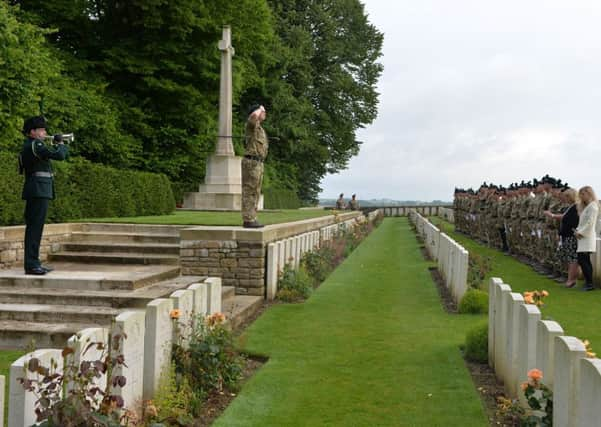'˜Be proud of what Ulster men did at Somme'


The Somme was Ulster’s defining engagement of the First World War and those who fought should be remembered for their courage and sacrifice, thousands at the Ulster Memorial Tower were told.
The Prince of Wales, Duchess of Cornwall, Northern Ireland Secretary Theresa Villiers, Archbishop of Canterbury Justin Welby and Stormont’s First Minister Arlene Foster were among those who attended the service of remembrance in Thiepval, northern France.
Advertisement
Hide AdAdvertisement
Hide AdThe Duke of Gloucester, president of the Somme Association, said: “I hope that as the years pass yet more generations will be proud of what was achieved at the Battle of the Somme.”
It was a service redolent with imagery of sacrifice.
The Last Post was sounded and poppy wreaths laid by Prince Charles, Arlene Foster, Ireland’s heritage minister Heather Humphreys, senior commanders from the Royal Irish Regiment and Ulster Unionist leader Mike Nesbitt.
Letters home and a victim’s account were read by Carol Walker, director of the Somme Association, and Royal Irish Soldiers Lt McCracken and Cpl Hyndman.
Viscount Brookeborough, vice president of the Somme Association, said France’s commemorative battle of the First World War was Verdun and Ulster’s the Somme.
Advertisement
Hide AdAdvertisement
Hide Ad“The local communities at the Somme gifted the land on which sits the Ulster Memorial Tower to Northern Ireland.
“It was modelled on Helen’s Tower which overlooks the training ground of the 36th Ulster Division in Co Down.”
The band, bugles, pipes and drums of the Royal Irish Regiment and military standards paraded amid rain and mud reminiscent of conditions in July 1916.
Retired Major Alan McFarland, chairman of Northern Ireland’s Somme Association, said: “Today we remember the soldiers from all nations who died here during the First World War, but particularly the courage and sacrifice of the officers, non-commissioned officers and men of the 36th Ulster Division.”
Advertisement
Hide AdAdvertisement
Hide AdThe Battle of the Somme began on July 1 1916. It was one of the bloodiest days in history.
The Ulster Tower lies amid the poppy fields, graveyards and preserved trenches where First World War artillery exchanges were fiercest and where lines of infantry walked to their deaths towards German defenders.
It was built on land gifted by the grateful French for the attack which British troops, from places such as east Belfast, made against overwhelming defensive lines.
Almost 20,000 died during the first day of a battle which generals hoped would produce a pivotal victory for Britain and France over Germany.
Advertisement
Hide AdAdvertisement
Hide AdWith massive amounts of blood spilt by soldiers from across Ireland, the dead have been memorialised as martyrs for their country by unionists who forged the new Northern Ireland some five years later and increasingly their sacrifice has also been recognised by the Republic of Ireland.
The 36th Ulster Division’s initial attack near the Somme village of Thiepval was a success but the force could not hold territory gained.